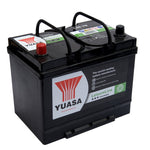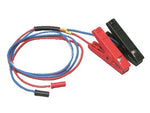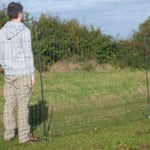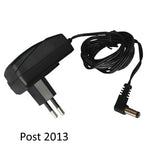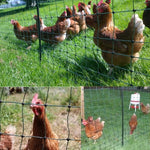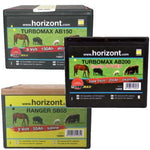You have no items in your shopping cart.
Electric Horse Fencing
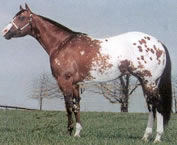 |
Electric Fencing for HorsesElectric Fencing for Horses is a safe and secure method of managing grazing. |
Electric Fencing suitable for Horses is continually evolving
Electric Fencing for horses was once snubbed in equestrian circles, everyone who owned livestock knew the basic rules: cattle and sheep needed to be enclosed with electric wire, but horses were best off behind wood planks, poles or hedges. With the advancements and improvement in fencing technology in the last ten years that has outstripped the advances made in the previous sixty years and electric fencing for horses now comes in forms well suited for use with horses. Modern electric fencing is the choice of a growing number of horse owners, who find that many of the old opinions that electric fencing is painful, unsafe, expensive, unreliable and difficult to maintain no longer hold true.
Safety for the horse
This is, of course, the foremost concern in any fencing decision. But what exactly constitutes a safe fence can become a complicated question. In some ways, horses are among the easiest animals to keep secure: They are domesticated and if they have all the food, water, shelter and friends they want, most horses aren't likely to try to leave their familiar surroundings. Electric fences for horses offer a barrier that they respect, and the newer materials and erecting techniques that are lighter in construction and designed to flex and have a "rubber band" effect. This ability to yield under pressure is less likely to injure a kamikaze pilot or aspiring Houdini.On the other hand, horses do pose a special challenge if it is determined to escape. Short of a 3-metre concrete wall, not much will hold in a 500-kilogram animal. You are, after all, simply fencing in the desire. The stronger the desire to escape - the more robust the fence needs to be.
Touch an electric fence for horses once and you'll know why it works; it's not very painful -- about the equivalent of a sharp slap -- but you'll remember the sensation, and you won't want to repeat it anytime soon. Horses, too, learn quickly that they don't want to bump, push through, rub against or chew on electric fences. The fence energiser is designed to send out a high voltage (about 6000volts), low amperage (about 100 milliamps) electrical charge for a very limited time, about 1/300th. of a second, every second. Compare this with two other scenarios.
1/. Static Electricity when you touch a door, about 30000 volts at 5 milliamps for 1/1000th. of a second, unpleasant but not lasting.
2/. Mains Electricity. 220volts at 13 Amps and constant, unpleasant and regularly causes death.
This sting (similar to a "thwack" from a riding crop) is what creates a psychological imprint within the horses' brain and it is this that fences him in. Electric fencing for horses running at a voltage as low as 2000v is able to create an impression with a horse under perfect conditions but this low voltage has other problems. Horses' hooves and hair are insulators so 2000v will be insufficient to bridge the insulated gap (particularly if they are on dry ground). A more viable fence should run at 6000 volts to be effective. Never a truer word may be spoken than;- "A wimpy energiser gives you a wimpy fence." This higher voltage will also help when the horse has a blanket (a very good insulator) but a second line aimed at the horse's knees will be as effective. Utilizing bait on the line will also work.
Mud Fever is a perennial issue with horses in the winter months. It is caused by the bacteria Dermatophilus congolensis found in mud. Although deep mud is not a pre-requisite cause of the condition, it does exacerbate the problem. Electric Fencing for horses is great in preventing areas becoming poached by sectioning off the grazing area and rotating that allowed to the horses. This then limits the time a particular area is subjected to horses and allows the rest to recover. Gateways are a particular problem as horses congregate at this point and pound up the mud. New gateways may be created at will a few metres away so eliminating this issue
Animals are the intended targets of electric fences, but anything else that comes in contact with both fence and ground will also complete the circuit. Very small items, such as blades of grass, allow a small amount of power to travel from the fence to the ground rods, but not enough to drain the entire system. (It's like a series of small holes in the fire hose, allowing some of the water to dribble away, weakening the pressure in the hose.) A short circuit occurs when an object, such as wire wrapped around a tree, reroutes all of the power from the fence to the ground system. The charge left in the fence is reduced to zero.
There are a wide range of conductors available to use in an electric fence for horses in the form of standard wire, poly twine, tape or rope. The first consideration should always be the conductivity. This is quoted in Ohms/meter (or Ω/m). The lower this figure is the better and should be linked to the price of the material. To illustrate this; an energiser capable of charging a fence 9 klm long with a conductor of 0.15 Ohms/meter will only be able to charge a fence 1.5klm long when using a 10 Ohm/meter conductor. Similarly, using a good conductor over a short fence will reduce the energy required and so extend battery life.
Can Horses "see" Electric Fencing?
Can an Electric Fence cause stress in your horse?
Again there is good trial data referring to this issue.
The physical format of the conductor you select is up to personal preference. In my experience they are fenced in by plain wire just as well as tape and although there are reports of horses getting torn to shreds by wire these are more likely to be with barbed wire. (Barbed wire should not be used with electricity.)
Here is a table outlining the pros and cons of the different conductors.
| Pro's | Con's | Use | |
|
hotShock HT Wire |
Very High Conductivity Very Long Lifespan. Does not stretch under tension. |
Difficult to work with. Not very visible |
Permanent fences only. |
| 7 Strand Pigwire |
Very high Conductivity. Long Lifespan Easy to work with. |
Not very visible. Stretches under tension. |
Permanent and semi-permanent fencing. |
| 20mm & 40mm Poly tape |
Highly visible. Relatively easy to work with. Good Conductors |
Large surface area open to Suns UV rays--reduced life. Badly affected by wind action. broken filament reduce conductivity. Stretches under tension. |
Temporary and some permanent fences. |
| Poly rope |
Very visible. Tightly wound fibres make it much stronger and reduces the area open to UV rays--lasts longer. Good conductors. Easy to work with. Middle of the price range. Not affected by wind. |
Stretches under tension. | Temporary and permanent fences. |
| Poly twine |
Average conductors. Very easy to work with. Not affected by wind |
Not very visible. Stretches under tension. Not very strong. |
Temporary fences. |

